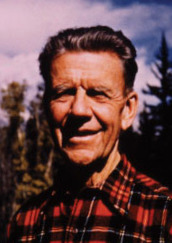Olaus J. Murie | |
|---|---|
 Murie in 1953 | |
| Born | March 1, 1889 Moorhead, Minnesota, U.S. |
| Died | October 21, 1963 (aged 74) Moose, Wyoming, U.S. |
| Occupation | author, ecologist, forester, wildlife biologist, and environmentalist |
| Nationality | American |
| Alma mater | undergraduate degree: Pacific University, Forest Grove, Oregon University of Michigan MS |
| Subject | Ecology, Conservation, Wilderness Preservation |
| Notable works | Elk of North America |
| Notable awards | Pugsley Medal, Audubon Medal, Sierra Club John Muir Award |
| Spouse | Margaret Murie |
| Relatives | see Murie family article |
Olaus Johan Murie (March 1, 1889 – October 21, 1963), called the "father of modern elk management",[1][2] was a naturalist, author, and wildlife biologist who did groundbreaking field research on a variety of large northern mammals. Rather than conducting empirical experiments, Murie practiced a more observational-based science.
Murie focused his research on the North American continent by conducting vast studies throughout Canada, Alaska and Wyoming. Through these constructive yet sometimes treacherous trips, Murie was able to gain valuable experience observing species and collecting specimens. During his first expedition to Canada, Murie discovered his passion for fieldwork and was able to develop resourceful skills from his indigenous guides, which were critical for his survival in such a harsh environment. Murie employed many of these same skills as he travelled to Alaska and finally to Wyoming.
These trips served as the foundation for many of his key ideas about wildlife management and conservation. As a scientist of the U.S. Biological Survey, Murie developed key ideas concerning predator prey relationships. Generally unheard of during his time, Murie argued that a healthy predator population was key to ensuring a harmonious balance between predator and prey populations. Murie used these ideas to improve current wildlife management practices.
Throughout his life, Murie advocated on behalf of wildlife conservation and management. With his wife, Mardie Murie, he successfully campaigned to enlarge the boundaries of the Olympic National Park, and to create the Jackson Hole National Monument and the Arctic National Wildlife Refuge. During his career, Murie held many respected positions within environmental organizations. He served as president of The Wilderness Society, The Wildlife Society, and as director of the Izaak Walton League.